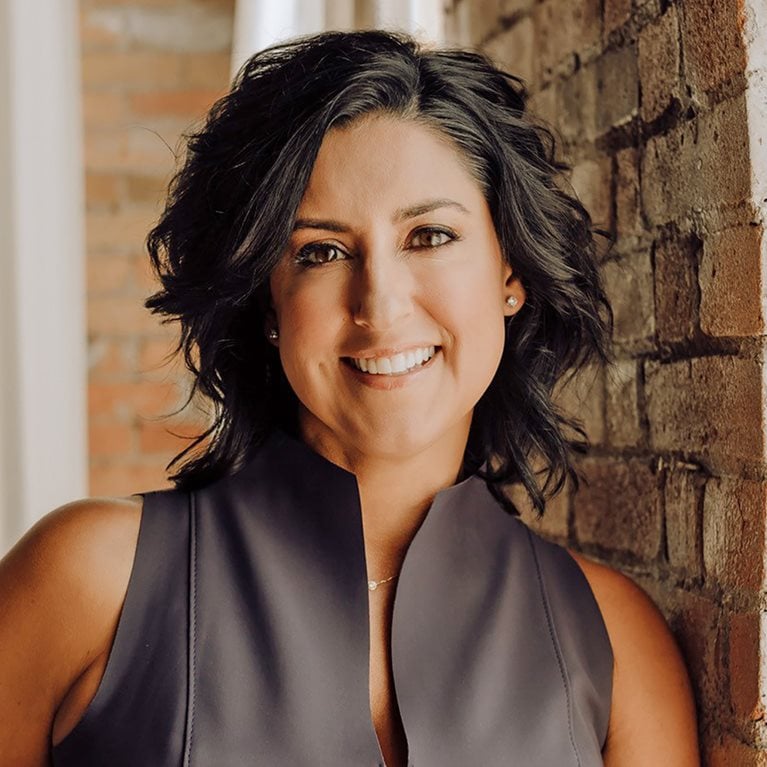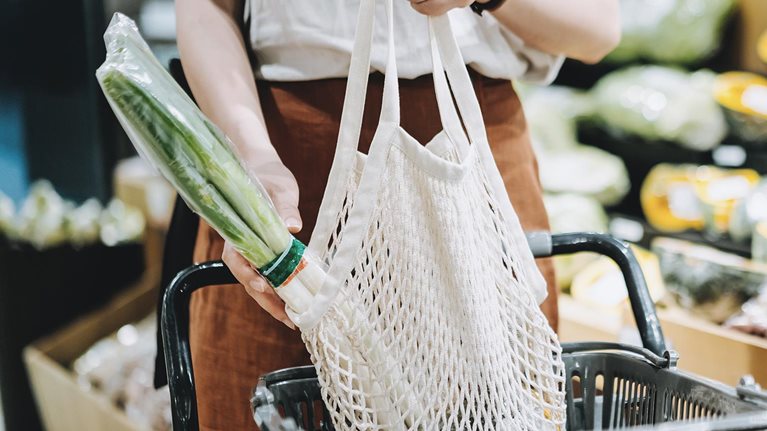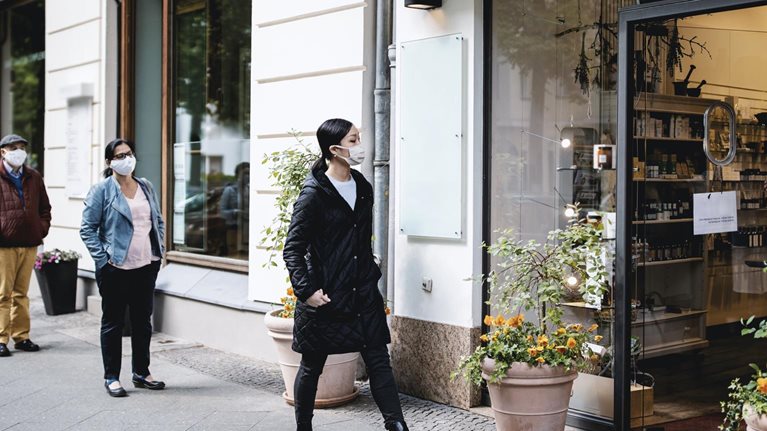“Consumers are shifting their spending toward products with ESG-related claims.” That’s one of the overarching insights revealed in a recent study conducted by McKinsey and NielsenIQ. The study demonstrated that, in many categories, there’s a clear and substantive correlation between consumer spending and sustainability-related claims on product packaging.
In this episode of the McKinsey on Consumer and Retail podcast, three authors of the report discuss highlights from their research. They also share new insights they’ve generated since the report was published. An edited transcript of the conversation follows. Subscribe to the podcast.
Monica Toriello: If you’re standing in a grocery store aisle and you see a product that claims to be good for the planet or good for society, are you more likely to buy that product? The answer, for many US consumers, appears to be yes, according to a new report that didn’t look at just consumer attitudes or intentions but also at actual consumer spending. It was a joint study by McKinsey and NielsenIQ, looking at five years of US sales data across 44,000 brands. Today, we’ll hear from three authors of the report. I’ll introduce them briefly.
Vinit Doshi is a senior expert based in McKinsey’s office in Stamford, Connecticut. Vinit has 25 years of experience in advanced analytics, focusing primarily on growth strategy in CPG [consumer packaged goods] and retail. Good to have you here, Vinit.
Vinit Doshi: Thank you so much, Monica. I’m really thrilled to be here.

Monica Toriello: Sherry Frey describes herself as a “passionate wellness thought leader.” She is vice president of total wellness at NielsenIQ—and, Sherry, a little later you’ll have to tell us exactly what that title means. Welcome to the podcast.
Sherry Frey: Thanks, Monica. Great to be here with you all.
Monica Toriello: Steve Noble is a senior partner based in McKinsey’s Minneapolis office. He coleads McKinsey’s work in retail transformation globally. Steve was on this podcast about two and a half years ago, and when asked about how his shopping habits had changed during COVID-19, Steve, you said, “I don’t buy pants anymore; I just buy a lot of wine.” Welcome back to the podcast.
Steve Noble: Thank you, Monica. Good to be here, and I think perhaps my personal habits during the pandemic were reflected in other people’s habits in that period of time as well.
Monica Toriello: Perhaps. Anyway, before we get into the report, Sherry, explain to us what it means to be vice president of total wellness at NielsenIQ.

Sherry Frey: Absolutely. We call it total wellness because we’ve found that the consumer is merging how they’re thinking about their personal health and wellness, the health of the planet, and social responsibility, or the health of others. We’ve found that the pandemic accelerated the convergence of these three elements. That’s why we call it total wellness: we find that it’s important to look at this holistically, the way the consumer is.
Monica Toriello: That’s a great segue into the report, which, again, used five years of sales data, from 2017 to mid-2022. It covered 600,000 SKUs in 32 CPG categories. I encourage our listeners to look up the report on McKinsey.com: “Consumers care about sustainability—and back it up with their wallets.” There are so many interesting and detailed insights in your report. What finding surprised you most?
Vinit Doshi: One of the things that surprised me the most is that sustainability claims have such an effect across categories. In many categories—whether they show outsize growth at a total level or not—there are brands and segments of products, including private-label products, that show a positive growth rate for products with claims. That surprised me because we often see that there’s a gap between people’s sentiment and stated intent versus their actual behavior. To see claims translate into actual sales was gratifying.

Sherry Frey: We went into the research with the hypothesis that it would be challenger brands, smaller brands, that would be driving the growth in sustainability. I was pleasantly surprised to see that private label was driving some of the outsize growth—and, frankly, we saw opportunity across almost all the segments, except for medium-size brands. I hadn’t thought that private label was playing such a role.
Monica, you mentioned what a massive undertaking this [report] was. This was five years of data, and it was the first time that we looked across not just hundreds of claims but also across brands of all sizes. The fact that we looked at private label as well is important in allowing us to see what the future of sustainability might look like for the entire CPG space.
We went into the research with the hypothesis that it would be challenger brands, smaller brands, that would be driving the growth in sustainability. I was pleasantly surprised to see that private label was driving some of the outsize growth.
Steve Noble: As we released the report, I was surprised by the breadth of the reaction we got. It wasn’t just US CPG companies that were interested; it was a broad set of stakeholders. Yes, CPG companies, but also retailers and other players involved in the sustainability space more broadly. I think we’ve had conversations with executives on five continents.
Category-specific insights
Monica Toriello: I imagine that the data isn’t just interesting but also valuable to business leaders, especially given the specificity of the insights—because you looked at which types of ESG [environmental, social, and governance] claims are correlated with higher sales in specific categories. Which aspects of the report are resonating with business leaders the most? What are you hearing from them, and what other kinds of questions are they asking?
Steve Noble: What’s interesting is when you dive into individual categories and you start peeling back the onion to understand what happens within the specific brands in that category. That’s what a lot of our conversations have been about: not overall spending but “what is going on within my category”—say, salty snacks or carbonated beverages. Those conversations have been quite interesting.
Sherry Frey: As clients are looking at this research, there has been a lot of gratitude. We see all this research out there about what consumers say, but what do they really do? This report gives fact-based information that shows there is a business case.
A second question we’re always getting is, “What are the price premium opportunities? How do we think about this from an investment perspective?” There is a differentiation opportunity, but there are also collaboration opportunities. That’s been a fun part of the client conversations: how we collaborate differently across the entire supply chain and even with our competitors.
Vinit Doshi: Where the product teams, merchandising teams, and category managers engage even more deeply is when it gets to the level of specific claims. What are the specific things that work in their category, and what works more often? That’s where the granularity has been particularly powerful.
Subscribe to the McKinsey on Consumer and Retail podcast
Sherry Frey: Vinit, it was interesting that we found there are certain claims in certain categories that absolutely can be a differentiator but might be table stakes in another category. Understanding what’s happening with those claims in other categories can be a lens into what the future might look like.
Steve Noble: One of the questions I found interesting is, “This is great research, but the past five years have been pretty unique: a very strong economy, then the COVID-19 years, then some recovery from that. How does this play out in a recession?” The data doesn’t cover a recessionary period, but there are a couple of anecdotes that have been interesting for me. I was on a panel discussion recently with a panelist who’d spent the 2008 global financial crisis leading grocery for a specialty grocery player. He said they’d tracked a series of sustainability attributes on a set of products, and those product cohorts continued to grow quarter over quarter through the financial crisis and that recessionary period, even as the overall business struggled.
You mentioned private label. Traditionally, private label accelerates during a recession and tends to hold on to that share. If the economy enters into a recession, you could imagine that private label—partly on the strength of these sustainability claims—will gain share. Our hypothesis would be that outperformance in a reasonably strong economy will likely hold up in a recessionary environment.
Sherry Frey: I agree. When we closed the study and re-ran the data, tracking a core set of attributes around wellness, we were surprised because we’ve seen some trading down and lower penetration in attributes like “organic,” but we haven’t seen that in the sustainability attributes as a whole. We found that inflationary impacts aren’t affecting sustainability the way they’re affecting some of the other wellness-related characteristics.
‘I’m personally being affected by climate change’
Monica Toriello: To what do you attribute this continued spending on sustainability? Are consumers’ mindsets now permanently changed, and is everyone now concerned about the environment and climate change? Or is something else going on?
Sherry Frey: Consumers are being exposed to so many more claims on packaging than ever before. They’re starting to see concepts like carbon footprint or water footprint across more and more categories in the store. If I see it on my food and on my beauty products, I really start to get an awareness.
We do know that there’s a subset of consumers who are apathetic. We find that about 5 percent of consumers are, like, “I don’t care” or “I’m not doing anything because it’s too overwhelming to do anything.” But 95 percent of consumers are on a spectrum, from people who are highly passionate and really educated to people who are just trying to do better day in and day out—and that is across all demographics.
Vinit Doshi: I think the news around climate change also plays a central role. The IPCC [Intergovernmental Panel on Climate Change] recently released a report highlighting the urgency, and it has an effect on the consumer mindset. Gen Z, we know, is one of the generations that cares more, and as they become more important to the consumer market, it’s really resonating.
Sherry Frey: Vinit, we did some research in November asking consumers why they care more about climate change, and you’re right—media was a top reason. Another of the top three reasons was, “I’m personally being affected by weather and climate impact.” In fact, 61 percent of consumers said the environment was having an adverse effect on their personal health. So they really are starting to tie this all together.
Steve Noble: When we looked at the question of, “Is this disproportionately driven by one or more demographic groups?” the answer was generally no. We found pretty strong adoption across age and income brackets. That said, Gen Z does skew a bit higher than the others, but make no mistake, it’s not solely a Gen Z phenomenon—it’s quite broad-based.
What companies are doing right
Monica Toriello: So that’s on the consumer side. Are companies doing things more right, maybe? There was a time when many people thought of a green product as a less effective product.
Vinit Doshi: It’s interesting that when we’ve looked at participation rates across categories, we don’t always see that every major manufacturer is necessarily leading. Sometimes they’re not participating in a meaningful way. This means they’re effectively leaving opportunity to drive ESG-led impact on the table. We do see that some of the leading companies are participating in a big way, and they have mixed success: not all of the products that they put claims on are necessarily outpacing growth, but, on average, they are. It takes a certain amount of investment to benefit from sustainability claims, like any other commercial decision.
When we’ve looked at participation rates across categories, we don’t always see that every major manufacturer is necessarily leading or participating in a meaningful way. This means they’re effectively leaving opportunity to drive ESG-led impact on the table.
Steve Noble: Monica, your question—“Are companies doing things more right?”—is an important one. The premise of all this isn’t to put a claim on the product for the sake of putting a claim on the product. The premise is that you have to be doing things more right; you have to be investing in sustainable products, organic products, fair-trade labor—the list goes on. Our belief is that companies are doing things that are making an impact in the ESG realm, and that is then showing up in their products. It’s not simply a marketing vehicle.
I don’t think I’ve yet had a conversation with a marketing leader; we’ve had conversations with R&D leaders, sustainability leaders, and overall corporate leaders. It’s not about marketing. Companies are doing things more right, and that is showing up in their products.
Sherry Frey: In the research, we also found that there’s higher consumer loyalty to the brands that have more ESG claims. As we’ve been sharing that with clients, it’s been resonating as a different way for a company to measure how they’re best serving consumers.
‘A long-term bet for success’
Monica Toriello: You’ve talked about ways that companies are getting this right. What are some ways that companies are still getting this wrong? What are some steps that they should be taking immediately now that this data is out there?
Sherry Frey: This research was done based on claims on packaging. We didn’t validate or confirm anything; we just took it at face value. We’re finding that companies are doing quite a lot on the sustainability front but aren’t making those claims on their packaging. We know that consumers are saying, “I want it on the package; that’s where I learn about a brand. I don’t go to a company’s website and I don’t look at their ESG report. I want it to be easy. Or I want it in digital discovery, when I’m searching on a retailer website.” We know that the real estate on packaging is very limited, but we think there’s opportunity for more brands to be communicating to consumers at the point of sale.
Vinit Doshi: To build on that, one of the questions that we’d like to look into is whether the claim has a greater impact when it’s shown on the front panel as opposed to being a smaller logo on the back side. Monica, to your question on what companies are missing, one thing is that some companies appear to be taking a wait-and-see attitude: “Let somebody else try it first, and we’ll follow.” We see cases where the first movers tend to have a greater—and sustained—advantage.
Steve Noble: Where some companies are perhaps missing the mark is in prevalence of claim—how often a claim is showing up on your product. It varies quite a lot by category, as you would have seen in the research. Our belief is that this isn’t about picking one product in one category and going big on it. It’s about a portfolio play. If you believe in sustainability, you’ve got to build it into enough of your product portfolio that it shows up and resonates with consumers. That doesn’t mean every one of those products is going to drive incremental growth, but we believe that on average they will.
If you believe in sustainability, you’ve got to build it into enough of your product portfolio that it shows up and resonates with consumers.
We see some companies in which sustainability is built into just 1 or 2 percent of their products. It doesn’t need to be 50 percent, but I do think there’s an opportunity to be bolder in investing across the portfolio, with some of this research to back you up.
Sherry Frey: Our research looked at six pillars, and one thing we found is that when companies played across more than one pillar—for example, if they made claims in animal welfare, environmental sustainability, or sustainable packaging—they would see two times the growth. That’s another area of opportunity for brands.
Steve Noble: In an environment with lots of economic uncertainty and the threat of a possible recession, do companies retrench a bit and say, “As much as we’d like to invest in sustainability, we just can’t do it right now”? There’s a little bit of concern there. My point of view would be that in past recessionary times, the companies that stuck to and invested in the things they knew were important to their business—customer experience, growth, the front line—came out much better and enjoyed better performance in not just the year or two after that period but in the ten years after.
I believe that investing in sustainability now sets you up for the next decade of success. If you fall into the trap of saying “we can’t really afford to do this right now,” the opposite could be true—you’d fall behind for the next decade. I think the evidence points to the fact that leaning into sustainability is a great long-term bet for success.
Giving sustainability a seat at the table
Monica Toriello: What does this all take? Should companies hire new kinds of people? Should they double the size of their R&D organizations? What are some on-the-ground things that need to happen for companies to benefit from some of the findings in your report?
Steve Noble: First and foremost is connecting the dots across the organization. In some companies, the folks who are focused on sustainability are off to the side and not really connected to the core business. They might offer a point of view when given the opportunity, but they’re not at the table when big decisions about R&D investment, product development, and assortment are made. That’s the first step. It’s not about hiring a bunch of people in function X, Y, or Z. It’s about making sure you’ve got the right voices and the right facts at the table.
Sherry Frey: It’s been fascinating as we’ve taken this research out to clients and talked to different sustainability officers and asked, “Where do you sit within the organization?” We’re finding every kind of answer: some sit under innovation, some report directly to the C-suite. I don’t know what’s right or wrong, but I think you’re absolutely right, Steve, that sustainability needs to be integrated into decision making.
Vinit Doshi: What we’ve seen in a best-in-class approach is bringing a cross-functional team of product designers, marketing people, and sustainability experts together to explore the possibilities and then test them with consumers in a light way. It doesn’t have to be a nine-month project. It could be simpler than that—pulling together what’s possible on the packaging, the product, and the claim certification and bringing it to market more quickly.
Sustainability in consumer goods: The next chapter
Monica Toriello: What’s next? What other questions are you digging into with regard to consumer goods and sustainability?
Vinit Doshi: One of the big questions we’re asked is about price premiums. We’re drilling into that. Another is how things have changed since June 2022. There’s been inflation, fears of a recession, companies cutting back, layoffs in the market. How is that affecting consumer behavior? So far, we see some resilience, but will that hold up?
Steve Noble: Here’s a little bit of news that’s come out since the report: we’ve dug into price premiums and found that across the six buckets of sustainability claims, all had a price premium ranging from 16 to 35 percent. Like most things in this research, it varied a lot by category. In categories like beverages and center-store grocery, the premiums tended to be 0 to 20 percent. In fresh meat and dairy as well as personal care, they were anywhere between 10 and 30 percent, and in some cases more than 40 percent. The price piece is an interesting complement to what we’ve already shared, and further reason to believe that there’s opportunity to invest in sustainability attributes more broadly.
Sherry Frey: Another question that’s come up is specifically from medium-size brands wondering, “What do we do? Where’s our opportunity? How do we play?” There’s more research to be done around why they don’t receive the outsize growth that everyone else does.
Other questions are about the consumer, who is evolving so rapidly. We have segmentations of consumers—from the super passionate to the small segment of people who are apathetic. How does this play out across the claims and categories? There’s a deeper level of dissection that needs to happen there.
Vinit Doshi: As governments start to mandate certain things, like we’re seeing in Europe, this issue is going to become more urgent. Companies need to have answers—for their stakeholders, employees, and customers—as to what they’re doing and how they’re going to meet their sustainability commitments. Being able to point to factual evidence, beyond consumer sentiment surveys, will be important.
Steve Noble: My closing thought for our readers and listeners would be, “Continue to talk about it and share it.” If you’re a CPG player, talk to the folks further back in your supply chain actually making the products. Talk to retailers selling those products. Engage in discussion about what this means and how we can collectively continue to advance the good we’re doing in sustainability and ESG. It shouldn’t be in a cone of silence. Sustainability ought to be something that we’re collaborating on and talking about broadly.


